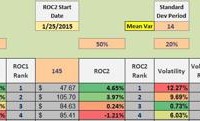Why Long-Term Investors Need To Be Looking Overseas…
Summary Value opportunity in foreign markets. Developed markets facing multiple headwinds. Investors looking to go international face many obstacles. Over long-term investment horizons, valuations can be a valuable guide for portfolio allocation. Most recently, we here at AlphaClone have been struck by the current valuation divergence across global equity markets. We believe long-term investors should be looking to increase their allocations to international equities in their portfolios. Why? In a word, price. The case for favoring international equities over U.S. domestic equities all comes down to price. This table sums up the current situation. (click to enlarge) (Table Source ) Whether it is developed market central banking policies, or other economic factors that have led to developed markets being richly valued, the bottom line is that equity markets in the U.S. and other western markets are historically expensive. As you can see in the table above, United States equities trade for 24x their cyclically adjusted price-to-earnings ratio or CAPE ratio. The historic average for U.S. equities has been a CAPE of around 16x. If U.S. equities regress all the way back to their historic average of 16x CAPE over the next 10 years, then investors would be looking at a -4% per year headwind. As price multiples contract, earnings have to grow that much faster to maintain the same price growth levels. Even if we only go only half way back to a 20x CAPE ratio, that would represent a -2% per year headwind for U.S. investors. All of these headwinds would predict anywhere from a positive 1% to potentially negative -2% real return for U.S. equities over the next 10 years. That is a lot of headwind for the investor who invests solely in the U.S.! Meanwhile… In the international markets and emerging markets, in particular, their average CAPE is just 13x. What’s more, if you focus in on just value stocks within emerging markets, you can find an average CAPE of 8.5x for those stocks. These markets have been hammered over the last three years but now they may offer compelling value to the patient long-term investor. This opportunity means investors can get almost 2-3x times as much value for their invested dollar through investing in stocks internationally as they can from buying the U.S. broad market indices. If you’ve invested Internationally, you’ve lived this growing valuation divergence. Through November 4, 2015, Morningstar’s Foreign Large Blend equity fund category is -4.8% in the past three months compared with their U.S. Large Blend equity fund category -0.6%. This foreign category is dominated mostly by actively managed funds. Annualized returns for longer periods can be seen below. (click to enlarge) Is the time right for foreign equities to start outperforming U.S. domestic equities? Timing is always difficult, but we believe that this is the area where patient long-term investors should be looking for value to increase their international equity portfolio allocations and take advantage of the discount they represent. How should you do it? Even if you are convinced of the opportunity that exists internationally, how should an investor best do it? International investing brings with it a host of additional challenges for investors including: Which countries to choose Which sectors to pick Which securities to select Foreign currencies issues When to enter/exit trades Tax implications What visibility do you have But probably the most important question is which managers should you trust to help you navigate the above obstacles over the long term. If the table above shows you anything, it shows you how difficult it’s been historically for active managers to beat the broader, cap-weighted market benchmarks. Despite the under performance recently of active management in the international arena, active management is still probably the best choice for long-term investors who would like a solution that can adapt to the changing market environments we are likely to face, and who would like to add a value tilt in their foreign investing.
